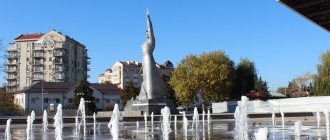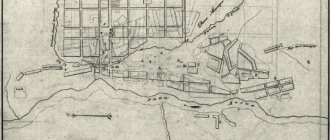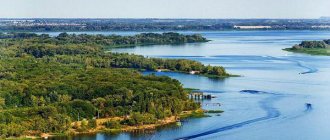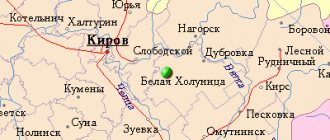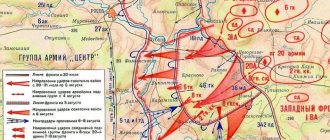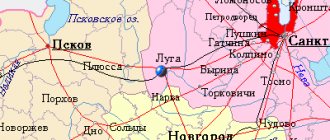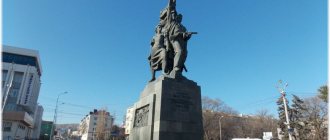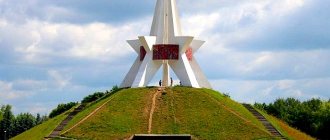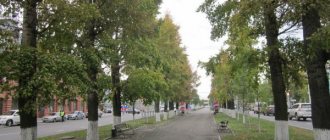We will talk about another agglomeration, tightly connected with the textile industry of Greater Moscow. However, the main attractions of Noginsk now tell more about the page of the biography that precedes the industrial stage. That is, about the “through and through” church Bogorodsk. There are so many temples here that we decided to present to your attention only the most famous ones. After all, the second “highlight” should also be shown - picturesque public gardens with memorable monuments. And also points where young tourists will tell their parents “Let’s stay!”
Main attractions of Noginsk
These completely different objects can be considered among the main beauties of the city.
Epiphany Cathedral and monument to Patriarch Pimen
It is more convenient to explore the “embankment” sights of Noginsk one after another, moving along the Klyazma. We recommend starting with a picturesque ensemble, made in eye-catching shades of white and blue. A colorful example of religious architecture appeared in 1876. It was built in the style of that era. The style is called Empire. Large, dome, columns, wide apse and 4-story bell tower, deliberately decorated with half-columns. Everything was within the framework of the building laws of that time. The religious institution is active. It runs a Sunday school and a library. The main shrine is the Tikhvin image of the Mother of God. The forerunner of the named structure appeared in the 17th century. Dedicated to Saint Nicholas. During the Soviet period, the building performed various unusual functions. Returned to believers only in 1989.
After walking literally 75 meters, the visitor will get acquainted with the figure of Patriarch Pimen. According to some information, Bogorodsk (now Noginsk) is the birthplace of this figure. In the world his name was Sergei Izvekov. Sergei became famous for his unusual role - he was the patriarch of All Rus' at a time when there was no longer any Rus'. He worked on the territory of an officially atheistic state - the USSR. We are talking about the 70s of the XX century. Captured in Soviet chronicles as the first Russian priest to speak at the UN against the nuclear arms race. He is also famous for convincing Mikhail Gorbachev to slowly return to the Russian Orthodox Church the rights and responsibilities that it had before 1917. The sculpture is made of bronze (Pimen is here in a canonical pose), and the pedestal is made of solid granite slabs. Steps made of the same material lead to this composition. The entire area described here is decorated with a well-groomed lawn, benches and flower beds.
The Epiphany Cathedral and the monument to Patriarch Pimen are historical landmarks.
Tikhvin complex: parish church, chapel and courtyard
What interesting things to see in Noginsk without leaving the embankment? 300 meters to the east the guest will reach another architectural ensemble. Its name is in the title. The temple itself appeared before everyone else. Back in 1846. At the moment we see his completely restored appearance. Red brick refectory, five-domed church of the Vladimir-Suzdal likeness. On the edge, a 3-tier bell tower characteristic of this “genre”. The reconstruction was based on photographs from pre-revolutionary times. The main relic is the relics of one of the Russian martyrs. His name was Konstantin Bogorodsky. Inside this building, in a hall with restored picturesque mosaics, regular services are held. In the courtyard, tourists will find two “fresh” remodels - a colorful church shop and a chapel erected in honor of Sergius of Radonezh. By the way, the holy spring gurgling not far from here was also christened with his bright name. Right next to the enterprise that produces rubber products. The Church of Our Lady of Tikhvin has a rich track record. Well-known priests in pre-revolutionary Russia cared for the parish here, and in 1891, Prince Sergei Alexandrovich and his wife Elizaveta Feodorovna visited the Tikhvin “abode of God”. She is the founder of several nunneries. In the desired space, the vacationer will find a pleasant-looking landscaped park. Its compositional center is the garden.
Church of the Assumption of the Virgin Mary and the monument to the 209th Bogorodsky Regiment
Having decided what to see in Noginsk in 1 day, you should definitely include this masterpiece on the list, located at the opposite (eastern) end of the agglomeration. It was built in the traditions of the same “empire” architecture (even the colors are like those of the buildings of the Epiphany Cathedral). The facility is located at the very beginning of Klyueva Street, sharing a courtyard with an equestrian club. Both buildings are again on the Klyazma embankment. The corner is very beautiful. On the presented site, vacationers will attend a divine service. And if there is no such desire, then they will buy an hour’s ride on a horse. Fortunately, there is somewhere to ride.
Probably, this memorial (installed at the intersection of Tikhvinskaya and 3rd International streets) tells travelers much more about the war years of Noginsk. But specifically about those when it was still called Bogorodskoye. The 209th Regiment got its name thanks to the “ancestor” of the current city. Here is a granite stone surrounded by a curb with a metal sign. It tells about the townspeople who fought on the fronts of the First World War. We are talking specifically about the period 1914 - 1916. Bogorodsk has produced enough heroes. Opposite is one of the two most popular bars here - “Roof”. On the other side (7 houses away) is the city hall. If military monuments are of particular interest to you, there is an anti-aircraft gun on Sovetskaya.
Bugrova Square and the Museum of Local Lore
Do you want to know what else to see in Noginsk? To do this, you will have to walk half a kilometer to the west - to the intersection with Trudovaya. The Noginsk Museum of Local Lore was built on the just-named roadway “artery”. But even earlier you will come across the forest park indicated first in the title. 5 alleys lead to the circle site. And in its center stands a sculptural work depicting Catherine the Great. Catherine II of Noginsk is mounted on a huge column and covered with gilding. So vandals cannot get to this invitingly sparkling city decoration. The granite pedestal stands on a concrete platform, and polygonal steps lead to it. The site itself is paved with paving slabs in such a way that under our feet we will see red rays diverging in different directions. Sit on a bench to quietly chew a pie or ice cream. Then to the mentioned NCM!
This exhibition consists of several halls filled with 10,000 storage items. Moreover, you will see the paintings in the hall, where you will pay 150 rubles for entry. The following departments are at your service: archeology and geology (“symbol” is a bust of a Cro-Magnon man, reconstructed by Gerasimov from skeletal remains), nature (dioramas of landscapes with stuffed animals and herbariums), WWII (military maps, personal belongings of officers and heroic soldiers, visual battle plans, remains of weapons, uniforms and, of course, photographic materials and documents found in the ground). Of particular interest is the branch of the educational institution - “Bogorodsk Post Station”. The exterior and interior of the Yamskaya station, thanks to which the village of Rogozhkino became a suburb, have been restored here.
Morozov's summer house - part of Glukhovsky Park
When thinking about what interesting things to see in Noginsk, do not pass by this “brand”. Its main difference is called the appearance itself. The heir of the famous Russian philanthropist, Arseny Ivanovich, once ordered the architect a mansion in the place that was eventually called Glukhovsky Park. This is a northeastern suburb, Krasnoslobodskaya street. The conversation turned to the authentic eastern shore of the Chernogolovsky pond, all the surroundings of which were once part of the Morozov estate. The summer house was created in the Dutch style. One-story, with an attic and a basement on the transverse axis. The facades are discreetly treated with stain, and their brick fragments are plastered. At the moment, one of the modern philanthropists is reconstructing the estate. The estate-reserve also includes a city park and ancient huts. Not far away (on Soviet Constitution Street) the domes of the Church of Konstantin Bogorodsky shine. This piece of Greater Moscow most convincingly sends us back to the past - from Noginsk to Bogorodsk.
Bogorodsk or Noginsk: to be or not to be?
The head of the Bogorodsky urban district of the Moscow region, Igor Sukhin, took an official initiative to rename the capital of the district, Noginsk, to Bogorodsk. This will allow the city to reach a new level of investment attractiveness and will renew its historical and tourist potential.
According to Igor Sukhin, today the issue is undergoing wide public discussion. Historians, youth and veteran organizations are involved in the process. At the same time, there are more supporters of the renaming in the city itself. According to the results of an independent express survey, about 52% of the adult population of Noginsk would like to return the historical name to their city.
Today, in the Bogorodsky urban district, preparatory work is underway to conduct an official population survey, which will take place at the end of November and will cover at least 8,600 residents of Noginsk. According to Igor Sukhin, the entire process of identifying public opinion will traditionally be built on the principles of transparency and accessibility. The regulations on the survey are officially discussed and adopted by the Council of Deputies of the Bogorodsk City District.
At the same time, all budget costs for renaming will amount to no more than 2 million rubles. Moreover, the process does not imply any financial burden on residents, and all replacement of documents will be carried out only as planned.
Let us remind you that one of the most famous initiators of returning the historical name of Bogorodsk to the city is the Minister of Foreign Affairs of the Russian Federation Sergei Lavrov. The head of the country's foreign policy department has historical roots in the Bogorodsky urban district and spent his childhood here.
For reference:
The city of Bogorodsk was formed by a personal decree of the Empress on October 5, 1781 and became the capital of the largest district in the Moscow province, Bogorodsky district. Over the years of its glorious labor history, Bogorodsk became one of the leading centers of the textile industry, one of the main cycling venues of the Russian Empire, was recognized as the city of the most beautiful schools, one of the first cities in Tsarist Russia, where Russian football and the architectural modernist style originated.
In 1930, by decree of the All-Russian Central Executive Committee, without taking into account the opinion of the population, the 149-year-old city of Bogorodsk was renamed Noginsk (in recognition of the services to the party of the Bolshevik leader Viktor Nogin), which became the center of the Noginsk region. In June 2000, the Council of Deputies of the Noginsk District adopted a unanimous decision “to rename Noginsk and return the city to its original name - Bogorodsk.” However, this decision was later postponed indefinitely. On June 5, 2022, Noginsk became the administrative center of a new municipal entity - created as part of the abolished
Share link:
Special places in Noginsk
The world's first monument to Lenin
What is absolutely unusual to see in Noginsk? For example, something that is included in some book of records. There is such an object - the most ancient monument to Lenin. A granite mini-stele with text reminds of this fact. In addition, it demonstrates Lenin’s thesis, which we have forgotten, “More trust in the forces of the working class...”. The fact is that the monument was erected the day after the death of the leader of the Revolution - in 1924. It was simply prepared as a lifetime gift from the very active Noginsk proletariat. In artistic terms, the statue is unlike any other image of Lenin. The sculptor Kuznetsov did not see Vladimir Ilyich and did not even have his photograph. But thousands of people willingly described it. So what came out of reinforced concrete was a very short man with one hand in his trouser pocket. And he raises the other (clenched into a fist without a cap) for his famous swing, familiar to us from newsreels. The location of the sculptural work is the courtyard of the Glukhovskaya manufactory (now Lenin Square, a public garden in front of the Furniture store). After the death of the Bolshevik leader, the same proletariat (12,000 determined workers of the Glukhov manufactory) demanded that the Soviets rename the nationalized enterprise the Lenin plant. The government hastened to comply with the order.
Noginsk near Moscow through the eyes of a resident
Noginsk is not my hometown, but now I live here. True, I’m planning to move, since the Moscow climate, as it turns out, is quite cold and humid. Therefore, if you have health problems, I do not recommend the Moscow region to you.
Noginsk is a regional ancient city with its own unique architecture. It is the center of the Bogorodsky urban district of the Moscow region.
It is very interesting that the city grew from the village of Rogozhsk, then transformed into the city of Bogorodsk, and after 1930 it was renamed Noginsk.
The city has always had many factories; historically, textile production developed here, which grew even more during Soviet times.
And in recent years, there has been an influx into the city, many factories and industrial zones have been built, in 2015 the Noginsk district was recognized as the winner and awarded a diploma from the Ministry of Investment and Innovation of the Moscow Region in the “Industrial Growth” category.
The most famous enterprises are: OJSC "Russian Sea", Bogorodsky cold storage plant (produces very tasty ice cream according to GOST), bakery, "Estima" (production of porcelain stoneware), OJSC "Foundry-Mechanical Plant" (art casting and forging, forged furniture, manufacturing stairs, fences made of non-ferrous metal and wood), Furniture Factory “MOON - Living Sofas”, Noginsk Chair Factory, Furniture Molchanov LLC, Oriflame plant.
There are a lot of chain stores: Dixy, Pyaterochka, Magnit, there is Ataki, the “Da!” supermarket has recently opened, Eldorado, Kari, many convenience stores, jewelry stores, construction stores are represented by the hypermarket “LEROY MERLIN” and Usadba, a lot of cellular communication stores - Megafon, Billine, Tele2, Svyaznoy, there are Fixprices, Okay (a large hypermarket, located along the Gorky highway next to Leroy Merlin and a large furniture center), Perekrestok, points for issuing online orders Valberrys, Ozone.
There are also restaurants, cafes, fitness clubs and gyms, and swimming pools.
There are bathhouses, dry cleaners, laundries, repair shops, beauty salons, and hairdressers.
For guests of the city, since many pilgrims travel to the city, many “Houses for Visitors” and hotels are open.
Travel agencies and insurance companies, hospitals and clinics, private medical centers, dentists operate for residents, and the Salty salt rooms have opened.
There are bank branches: Sberbank, MKB, Pochtabank, Promsvyazbank, VTB, Rosselkhozbank, Vozrozhdenie, and many different ATMs in different parts of the city.
There are also real estate agencies.
You can get to Moscow by buses that go every 25 minutes to the metro stations Chkalovskaya, Shchelkovskaya, Partizanskaya and Kursky Station (by express the travel time is about 1 hour), as well as from two railway stations Noginsk and Zakharovo. Usually local residents and residents of nearby villages come by car, leave it in a free parking lot near the Zakharovo station and go to Moscow.
To save time, they get to the Reutovo station, and there, in the Novokosino metro station, and here it is, underground Moscow.
By car, everyone travels to Moscow along the Gorkovskoye Highway, depending on the time of day and day of the week, you can get there in 35 minutes or 2 hours.
There are a lot of vehicles in charge of the city, private taxi drivers (Yandextaxi, Uber aggregators), but there are no more trams here, the railway tracks, however, have not all been completely dismantled yet. And if you drive around the city by car or minibus, you can see where the tram route used to be. Many residents have their own personal transport. There are also carsharing cars.
There are also favorable conditions for families with children; there are nurseries, kindergartens, schools, lyceums and even universities, which allows you not to travel to Moscow, but to study from home. For special children there is a boarding school, a special school, music, art and sports schools. There are many clubs open for children in the cultural center next to Glukhovo Park. Private education has been developed.
There is also a place to relax: there are 2 large parks, one Komsomolsky, the other in the Glukhovo microdistrict, the rest of the parks are smaller.
Alley of Fairy Tales
The first is notable for the Alley of Fairy Tales and the Ferris Wheel; the second historical center is the Morozov Estate; you can walk through its house after agreeing on a tour. In the same park there is a mini complex for children to learn the rules of the road, and there is a dedicated bike path for cycling enthusiasts. The park itself is full of pine and larch trees, and if you are looking for a place for photos in nature, this park is what you need. At the entrance to the park there is a bench-house with shelves on which you can bring books for free exchange, put your own or take those available there.
Concerts and folk festivals are also constantly held in Glukhovo Park, especially during major holidays (Maslenitsa, New Year, March 8) - local television comes.
Behind the park there is a newly built modern Znamya stadium, where our famous athletes train, new stands with a capacity of more than 2000 people.
There is also one large stadium, “Avtomobilist”, in addition to the football field there are running tracks, an outdoor tennis court with rubber coating, a mini-football area, and gymnastics equipment.
There is also a theater in the city, where metropolitan artists, conversational artists, singers periodically perform and plays are staged. Prices are reasonable.
The city is famous for its temples, one of the most famous is located on the street. Klimova - Church of St. Matrona of Moscow. The Epiphany and Tikhvin Cathedrals are very beautiful, and there is also a Muslim Church. There are parishes of other faiths.
Generally speaking, Noginsk consists of microdistricts formed from former villages and villages: Istomkino, Domozhirovo, Glukhovo, Yamkino (joined the city in 2022), etc.
It is noteworthy that the center in this city is considered to be the outskirts in the general sense of the word - a place near the railway and bus stations (they are nearby).
Despite the fact that there is a local beautiful Arbat with a pedestrian area and the historical center of Glukhovo.
Of the new buildings, it is worth highlighting the Polet residential complex, Istomkino residential complex, Central Usadba residential complex, Akademika Fortov residential complex, Belyakova residential complex, these new buildings are proven, the rest are problematic - as a rule, long-term construction.
The city is not bad for living; the proximity to Moscow is also pleasing, so you can get there without transfers using any transport.
There are places to relax - parks, restaurants, cafes, just walk around to take pictures of ancient buildings and spiritually cleanse yourself by visiting any of the temples.
There are places to improve and maintain your health and cure - many clinics, both private and public, dentists, salt rooms, swimming pools, fitness centers.
There are places to make yourself beautiful - beauty salons, hairdressers.
There are shopping centers with famous brands of clothing and shoes.
You won't go hungry either - Dixie, 5's, Magnets at every step.
Yes, and creative diversity - you can go to the theater.
The Active Longevity program is open to pensioners.
There is also a lot of work for the working-age population; you don’t have to go to Moscow.
When choosing housing, it is better to give preference to new buildings and those already renovated by the owner. Because repairs from the developer are done by Uzbeks, but they do them poorly, as verified by personal experience. Well, for developers, such workers greatly reduce the cost of repairs.
Because, as a rule, to make repairs (good repairs, not from the developer) you will have to spend about 1 million rubles.
If in a nutshell about new buildings in Noginsk, then here is a short overview:
- Residential complex Polet - apartments for sale without finishing, standard and unusual layouts. There is only one entrance to the residential complex from the city side; there are traffic jams at the entrance, because... you need to cross the railway tracks along which electric trains go. The residential complex is built up point by point, there is a kindergarten, a school, and convenience stores. Not far from the forest and the Avtomobilist stadium. Cell phone reception is very poor. Since the building density is high, there are therefore problems with parking and utility bills are higher.
- Residential complex Istomkino - apartments with and without finishing, there is a rented building, there is a swimming pool nearby, you need to go to shops, a kindergarten, and a school. There is still parking available. The stadium is nearby and there is also a highway nearby - all the dust and fumes in the apartment, it is better to immediately install an air conditioner, utility bills are higher.
- Residential complex Centralnaya Usadba is a new ecologically clean area of Noginsk, annexed in 2022. The residential complex was commissioned, monolithic brick, plenty of parking spaces, nearby a yakhont forest, a school, kindergarten, hospital, clinic, everyday stores within walking distance, a small communal apartment. The advantage of this new building is that it is located in the Small Moscow Ring Road (MMKAD), Noginsk itself is located beyond the MMRKAD
- The residential complex on Akademika Fortova was built by the Finnish company YIT. The house is a panel, but with ventilated facades. The downside is the problem with parking and access to the highway, where there are always traffic jams and accidents, utility bills are average.
- The residential complex on Belyakova (Zarechye microdistrict) is an established area, one might say that it is no longer a new building, but still it is also included in this list. The building density is spotty, which means parking is a problem. But shops are within walking distance, you need to drive to school and kindergarten, and utility bills are higher.
Entrance area of many stores
While walking around the city, you will definitely notice how beautifully decorated the thresholds, staircases, entrance areas are, what beautiful forged benches - all this is produced by JSC LMZ.
In the Glukhovo area there is an exhibition hall where you can not only see various products of figured forging, but also purchase them for personal use.
Another important feature of the city is that many people keep dogs - and in the city itself there is a large dog kennel, as well as a canine service, where they will help teach your dog to properly serve the owner and follow commands, and this service also trains guide dogs for people who have vision problems.
Over the past 2 years, the city began to transform, abandoned buildings in the historical center began to be reconstructed, and this greatly changed the appearance of the city. He began to look more like Peter.
Near the Morozov Estate (Glukhovo microdistrict) - they made a beautiful descent to the Chernogolovsky Pond, in the summer fountain figures (pearl, mermaid, goldfish) are installed on the surface of the pond, there are restaurants on the water, barbecue is grilled in the park and the atmosphere is like at some coast of the southern city. Fireworks in the park are also frequent in the summer, so if you look at an apartment in this area, get ready for a fun summer (holidays, weddings, fireworks, almost every day).
Yes, another important point, in Noginsk, utility bills are not small; in the city center and in the old building, for a 1-room apartment with an area of 30 m2, you can pay from 6 thousand rubles. In new buildings, as a rule, the price is 2 times cheaper.
And despite the fact that the Housing and Communal Services Administration has changed the water pipes, from time to time all residents of the city, without exception, have yellow water flowing from their taps. More often in old buildings, much less often in new buildings. It is absolutely forbidden to drink water from the tap without additional purification measures - it risks poisoning!
Residents either install filters, which are not very helpful, or buy water in 5-liter bottles, or go to springs and wells.
The construction of a new high-speed railway line Moscow-Kazan has already begun; it will bypass Balashikha and Elektrostal, with a stop in Noginsk. Travel time will be 3 hours 20 minutes.
At first, as a motorist, it was strange to me that the speed limit in the city was 40 km per hour, there were a lot of cameras and even more lying policemen.
It is very pleasant that most of the traffic lights are duplicated, there is a digital display with a countdown, and for pedestrians when crossing there are light indicators with a letter designation, with a voice indicator, and red “STOP”, green “GO”.
And one more aspect, the closer to the city of Elektrostal, the stronger the terrible smell; most Elektrostal residents envy Noginsk residents, because they feel less of the smell from industrial production, factories and the incineration plant.
Another plus is that there is a stadium in almost every microdistrict. The city pays special attention to health and sports.
And sailing races take place on the Chernogolovsky Pond, beloved by residents. And this year 2022 there was a huge race of cyclists, athletes came from other countries, the city was closed to entry and exit.
And, of course, it is impossible to imagine Noginsk without fountains; you probably won’t see so many fountains in any city. As they say, the mayor of the city has a mandatory point on them - every district should have a beautiful oasis. You will also see the fountain when entering the city from Moscow.
The most beautiful places in Noginsk
All the sights of Noginsk that we see on most online resources or on TV are “business cards”. And they are touched upon in this chapter of our longread.
Fontannaya Square and the immediate surroundings
On this spot (located at the intersection of Gorky, International and Sovetskaya streets) you will have the opportunity to appreciate another advantage of the city - a huge cascade of fountains. They go along the perimeter of the ponds, which have the appearance of a strict pattern in plan. Water rushes out of hundreds of nozzles at once. The hydro-engineering attractions of Noginsk create coolness in the heat, causing genuine delight in children. There is a lot of granite, elegant benches, fences and lanterns made with artistic forging. By the way, on the nickel decorated with columbariums, French lawns and elegant sidewalks, you also have access to the Drama and Comedy Theater. This building was erected in the New Art Nouveau style. And across the road the corner where all the WWII memorials are concentrated will “look” at you. Including the already mentioned anti-aircraft gun and another chapel. The presented fragment of the central blocks is recognized as the most photogenic (by both citizens and guests of Noginsk).
Main city park and Fairy Tales Alley
By sending the request “What to see in Noginsk?”, you can get this name. Or rather, two. The fact is that the eastern “portal” to the recreation area (the name of which is in the top line) is located in the Alley of Fairy Tales. It is at the intersection of Komsomolskaya and Lesnova streets. Here you will find a bronze squirrel gnawing on golden nuts (sitting in a cage), and 7 dwarves with Snow White, and even a Russian stove. Heroes of Soviet cartoons lounged imposingly on the benches. In terms of vegetation, the central central park is a mixed forest (birch, pine, alder, aspen and spruce live here). Among several sidewalks there were attractions - for small children, as well as teenagers and adults who are not afraid of any extreme sports. It is important that there is where to buy both drinks and sweets. You can actually find more serious food in one of the local cafes. Of course, toilets are also at your service. In the same area, a large... ruble hangs on one of the trees! There is a pond and a bridge nearby. In general, there are more than enough subjects for a photo shoot! The center of the park complex is the Good Angel of Peace, installed on a high pillar. There is a round colonnade around it. There is a recreation center. It remains to add: the oldest (entirely wooden) residential areas are located nearby. And they contain examples of the austere architecture of the former Bogorodsky district. The gymnasium building was once built in the “flaming” Art Nouveau style. It still performs its intended functions today.
Near the bus station: monument to Victor Nogin and Karl Marx Square
The rating of “iconic sights of Noginsk” continues with another feature – very beautiful spaces located on both sides of the main bus station. In front of the transport terminal is the Nogina park. Walking along it, you immediately notice Viktor Pavlovich himself. A Marxist philosopher, who after the Revolution became People's Commissar for Trade and Industry, together with Kamenev and Rykov, he opposed Lenin's “April theses”. Nevertheless, he became the first Bolshevik to achieve the position of chairman of the Moscow Council of Workers' Deputies. His second well-known merit was lobbying the interests of the Bolsheviks in the Pre-Parliament at the end of September 1917. It played one of the fateful roles in the process of the RSDLP (b) seizing power in the Soviets (after October). The merits of the figure made it so that his name was awarded the honor of becoming a toponym on the map. The head decorated with a “Chekist” cap looks intently at those who are not “unloaded” from the buses. Nogin's gaze is directed in the opposite direction - to the railway station. Just like the telegraph and the post office, this building is of greatest importance to any revolutionary. Moreover, suspicious people gather at the Vstrecha cafe.
To the east of the bus station, the tourist will find himself in another green area - K. Marx Square. In addition to the familiar bearded image of the author of “Capital”, in the named recreation there are four stone memes – to Victims of Political Repression, Prisoners of Fascism, WWII Warriors and Internationalist Soldiers. People pray for everyone in the chapel. Several tiled sidewalks, 4 columbariums, well-grown trees.
Exhibition Center "House of Artists"
This landmark of Noginsk is known throughout the Moscow region. Because famous brush and pencil masters in the Moscow region exhibit here. It deserves your attention for a number of reasons. The first is, of course, the paintings themselves. The second is unique fur coats for sale. The third reason to visit here with a camera is creative meetings not only with graphic artists, applied artists, sculptors and painters, but also theater and film actors. The establishment is located in the Volodarsky microdistrict, on Klimova Street, 35. This is a continuation of the embankment. Official “entry” into the exhibition hall costs 150 rubles. We look at fur coats for free.
The world's largest Oriflame factory
What to see in Noginsk, moving to the end along the famous (longest) Magistralnaya (3rd International) street? Of course, the production complex of the international company named in the title. This is the largest investment project in terms of volume (investment – 150,000,000 euros). The façade looks more like a shopping mall rather than an enterprise. The company's management also turned the industrial site into a site for tourist excursions. Visitors will not only be beautifully presented with the manufactured product in an amazing exhibition complex, but will even be shown how it is produced and how it is stored. The total area of the production complex is 26.5 hectares. Around it there is also a recreation area with greenery, fashionable benches and more. There are workshops not only for the production of cosmetic products themselves, but also for packaging for them. And also a noisy and massively armed logistics center. The warehouse looks even more majestic, the shelves of which “run away” to the height of a 5-story building. Are you a cosmetics lover? Then pay a visit to the local ice cream factory. But the Ministry of Health warns: this product is dangerous for your throat.
History of the Bogorodsky region. Legends of Noginsk: Catherine the Great, hero of the war of 1812 and Pushkin
Noginsk, located near Moscow, has a rich history. More than 600 years ago it was a small village of Rogozhi with a yam yard. In the 18th century, Catherine II visited it, thanks to her the village turned into the county town of Bogorodsk, which became famous for its textile production. A correspondent for the Noginsk news agency studied local legends and found out where the name of the settlement came from, what Alexander Pushkin did there, and what events took place here during the Patriotic War of 1812.
Coachmen and textile workers
© Photo, from the archive of local historian E. Maslov
Information about Noginsk-Bogorodsk is found in many ancient documents. For example, in the spiritual charter of Dmitry Donskoy from 1389, the village of Rogozhi, which is located on the Rogozhka River, is mentioned. The history of the Moscow region city began with this settlement.
According to archaeological excavations, the village of Rogozhi arose during the time of the first Slavic settlements at the end of the 13th - beginning of the 14th century.
There are several versions of the origin of the names of the village and the river on which it stands. One of them connects the toponym with the cattail plant, which grew everywhere here. It is often confused with reeds, another representative of the flora that grows in wetlands, on the banks of rivers and lakes. Another assumption is that the name of the village comes from the coarse bast cloth matting, which was made in these places.
The village of Rogozhi was lucky: it was on an important economic highway - the Vladimir Road. Horses were changed here. Carts with furs, fish, bread and other goods moved through the village from Moscow to Vladimir and back, thanks to which trade actively developed there.
At the beginning of the 16th century, the Yamskaya Sloboda appeared here, and the village was renamed Old Rogozhsky Yam. The so-called “Yamskaya chase” began in Kazan and Nizhny Novgorod. In 1646, coachmen and their families owned 44 of the 50 households in the village of Stary Rogozhsky Yam. By the way, the first postal station on the Vladimirskaya road appeared in Yamskaya Sloboda.
However, the Yam craft gradually fell into decline and was replaced by various crafts. During this period, handicrafts appeared in the village, papermaking and silk weaving began to develop, and small factories producing silk fabrics arose.
In 1773, in the village of Stary Rogozhsky Yam there were 54 weaving mills.
The village was inhabited by merchants, townspeople, commoners, coachmen, and clergy. The population grew and by 1781 there were 561 people. It was this year that became a turning point in the history of Old Rogozhsky Yam. Empress Catherine II came to the village and renamed it the district town of Bogorodsk. With its formation, the textile industry appeared within the Moscow province.
The most beautiful school in the Moscow region: the 100-year-old temple of science in Noginsk. PHOTO TAPE>>
"God-Born Land"
© Photo, Anastasia Marukhlenko, Noginskoe IA
The most popular legend, well known to the residents of modern Noginsk, is the legend about the origin of the name Bogorodsk. It says that once Catherine the Great visited the estates of the great Moscow princes and ended up in the territory of the current Bogorodsky district. Suddenly a terrible thunderstorm broke out - the heavens cast lightning and streams of water onto the earth. The Empress began to pray, calling on the Mother of God for salvation. And the storm stopped, and the bright sun came out from behind the clouds. Catherine exclaimed: “God-born land!”
It is unknown whether this actually happened. However, it was Catherine the Great who in 1781, by her decree, transformed the village of Stary Rogozhsky Yam into the district town of Bogorodsk in connection with the administrative reform that was then being carried out.
Paying tribute to this important event, in 2006 - for the 225th anniversary of the city of Bogorodsk - a column with a sculpture of Catherine II was erected in the center of Noginsk in the picturesque Bugrova Square. Interestingly, the monument is clearly visible from the street with the historical name Rogozhskaya.
© Photo, Anastasia Marukhlenko, Noginskoe IA
Another legend says that the name of the city of Bogorodsk and the entire Bogorodsky district was given according to the date of its formation on the Feast of the Intercession of the Holy Virgin.
There is also an assumption that the city got its name thanks to the Church of the Assumption of the Virgin Mary, which is located not far from it.
The city received its current name in honor of the Soviet politician and revolutionary Viktor Nogin in 1930 by decree of the All-Russian Central Executive Committee. In the 2000s, the Council of Deputies of the Noginsk District decided several times to return the historical name Bogorodsk, but for various reasons this was postponed.
One day at the Noginsk Center of the Ministry of Emergency Situations: how future rescuers are trained>>
People's hero
Many legends are associated with the name of the hero of the Patriotic War of 1812, leader of the partisan detachment Gerasim Matveevich Kurin. Perhaps the people could embellish real events and exaggerate the exploits of their fellow countryman, but historical facts confirm his heroism.
During the War of 1812, peasant Gerasim Kurin led one of the largest peasant partisan detachments that went into the forests to resist Napoleon's army and wage war behind enemy lines.
At the beginning of hostilities, Kurin's detachment numbered 200 people, but soon its number increased to 5,300 foot and 500 mounted partisans. They fought with the French and captured convoys with weapons and food.
Historical materials contain interesting facts about the struggle of partisans in the rear of Napoleonic troops, including about Kurin’s detachment. For example, from September 23 to October 2, 1812, he participated in clashes with the French seven times. In one of the battles, poorly armed peasants got a real treasure: almost two hundred rifles and pistols and 400 cartridge bags.
Another striking episode of the war was the seizure of a grain train. The French Marshal Ney was enraged by the insolence of the partisans and sent two squadrons of dragoons in his rear “to stop the outrages.” They were defeated, and a significant part of the cavalrymen were captured.
After several successful raids, the detachment became so strong that Kurin decided to attack Bogorodsk, occupied by the French. But by that time Marshal Ney had already received an order to retreat to Moscow. Kurin missed him by only a few hours.
Popular rumor claimed that Kurin's detachment reached 8 thousand people. He destroyed 5 thousand French soldiers. Kutuzov himself twice summoned Kurin to Moscow and personally awarded him the St. George Cross and the medal “For Bravery.”
Historians say that Gerasim Kurin was not only awarded high awards, but also received a colossal cash payment - 5 thousand rubles in banknotes.
After the war, Gerasim Matveevich was appointed head of the Vokhona volost and, having lived until he was 73 years old, died in his native village of Vokhna. His descendants still live in Uspensk to this day.
Bogorodsk residents carefully preserve the memory of the legendary countryman. It is quite possible that Kurin’s name and feat will soon be immortalized in a monument. This idea was put forward at one of the last meetings by the people's representatives of the Council of Deputies of the Noginsk Municipal District.
Equestrian club in Noginsk: hippotherapy, or how a horse heals>>
Famous industrialists and Pushkin
© Photo, from the archive of local historian G. Furaseeva
On the stele in honor of Catherine the Great in Noginsk are carved the names of the glorious Russian entrepreneurs Morozovs, Elagins, Shibaevs, Zotovs, Brunovs, who contributed to the rapid development of industry in the Bogorodsky district and the growth of the city of Bogorodsk.
“In 1856 Z.S. Morozov established a joint stock company, which became one of the largest textile enterprises in Russia. Textile factories mainly produced cotton, silk, and woolen fabrics,” says the materials of “Bogorodskoe Local History.”
© Photo, Anastasia Agafonova, Noginskoe IA
According to legend, Alexander Sergeevich Pushkin was passing through Bogorodskaya land when his carriage broke down on the way to Moscow. The poet spent several days in the hut of a local weaver, working on poetry.
According to materials from local historians, by the end of December 1885, a 15-verst railway line was built through Bogorodsk. It connected the city with the station in Fryazevo of the Moscow-Nizhny Novgorod Railway.
Architectural monuments
© Photo, from the archive of local historian G. Furaseeva
In the village of Voskresenskoye near Noginsk, one of the best surviving monuments of wooden architecture in the Moscow region has been preserved - the Ascension Church, built in the times of Peter the Great, in 1705. Here in 1833, at the expense of parishioners, an elegant Church of the Intercession of the Virgin Mary was erected.
Famous and interesting architectural monuments are the Berlyukovskaya Hermitage, the Assumption Stromynsky Monastery with the preserved chapel over the grave of St. Savva Stromynsky, the Epiphany Cathedral and the Tikhvin Church.
The industrial revolution of the mid-19th century became a prerequisite for the construction of world-class buildings in Bogorodsk, brightly and expressively bearing the features of the Art Nouveau style.
Many buildings in Noginsk, built in the Art Nouveau style, are wonderful works of architecture. Among them are a women's gymnasium - school No. 2 named after Korolenko, the Novotkatskaya factory, a factory school - school No. 10, a pedagogical college and others.
A walk through the center of modern Noginsk with a tour of the city's local history museum will be an interesting adventure for history buffs.
How to get to Noginsk:
– by train from Kursky station to Noginsk or Zakharovo stations;
– by bus No. 322, No. 382 or No. 394 from the Partizanskaya metro station or by bus No. 320 or No. 360 from the Shchelkovskaya metro station to the bus station in Noginsk;
– by private car along Gorkovskoye Highway.
Noginsk Museum of Local Lore:
Address: Noginsk, pl. Bugrova, 2, “Noginsk Museum and Exhibition Center”
Telephone
Opening hours: Tuesday, Wednesday, Friday, Saturday, Sunday from 10:00 to 17:00, lunch from 13:00 to 14:00, Thursday from 14:00 to 20:00 without lunch break
Website: https://noginsk-muzey.ru
What to see in Noginsk in 2 days
Having an “extra” day will give you a chance to explore all the interesting things. Read how and what to see in Noginsk in 2 days:
- We save time: we start the promenade from the station area - that is, from the squares of Victor Nogin and Karl Marx, as well as the monument to the 209th regiment;
- on the way to the northwest you come across Fontannaya Square, the Drama and Comedy Theater;
- further along this course is Bugrov Square with a local history museum. It's time for lunch here;
- We recommend ending the day with a walk along the entire embankment – Epiphany Cathedral, Tikhvin Church, House of Artists, Church of the Matrona of Moscow, Lenin;
- the next day, start from the points where you need to go - the former Morozov estate, the Russian Compound (everything lies in the north-east direction);
- after lunch, the opposite half of the city - City Park, the Einstein Museum and the Jumanji shopping center. Have dinner there too;
- Before going to bed, we recommend the city park with the Alley of Fairy Tales and the Oriflame factory.
What to see in Noginsk with children
Einstein Museum
Who said that physics is a very boring science? Among the list of “children’s” attractions in Noginsk, you will come across an institution on Revsobraniy Street, 2G. All the wonders of physical phenomena are collected here: a tabletop tornado, indoor lightning, pocket perpetual motion machines, 4 quite funny Archimedes levers, an “entertaining” plasma ball, tools for creating optical illusions and even easily controlled “soap-building” material. There are 50 exhibits in total. And they all fit into a completely modern building. Entrance to the interactive kingdom of the “fundamentals” of all sciences will cost 350-380 rubles. Maybe this is more expensive than the cost of visiting some state museum. But a young guide is provided to you free of charge. He will tell you about the quest room. And for the event there you need
The benefit of an entertainment center is that kids or schoolchildren (and you with them) can play billiards, slot machines, draw, watch a giant TV, jump, and roller skate in one place. Look at the artistic knitting of figures from balloons, and also eat or drink something memorable and incredibly tasty (baked goods, cocktails, etc.). It makes sense to order any children's party. The chefs, DJs and animators of the Coco Bongo cafe are here to help you. The center is located on the 1st floor of a large “modern” building, built in the suburban residential complex “Polet” (Poselkovaya St., 72). The cost of an hour of various entertainment services does not exceed 400 rubles. Nearby is the huge Annunciation Arboretum. In it (along the road) there is an impressive example of an anti-tank hedgehog (preserved from the time of the Battle of Moscow) and a stop.
Mini-zoo “Russian Compound”
If you have already decided what to see in Noginsk in two days, then leave a couple of hours for this interesting place, located in the residential area of Zhilino (6 km from the city center, the territory of the Yakhonty country hotel). An untouched forest, a mill, a cafe in the form of old Russian gazebos (there is even a samovar and bagels) will create a pleasant atmosphere. It is precisely in such an environment that one should communicate with “our smaller brothers.” This crazy company includes rabbits, goats, forest flying game and poultry. In another stall, completely obedient horses are waiting. If necessary, they will be quickly harnessed. All prices are negotiable. Feed store right on site. Opening hours: from 10 to 20 hours (break from 13 to 14). For hotel guests, many things are provided free of charge.
In winter, people enjoy downhill skiing and horse-drawn sleigh rides. In general, if you want to find yourself in the distant past, here’s a real Russian courtyard...
All the attractions of Noginsk described here will allow guests of different genders and ages to spend their weekend in a fun and educational way, gaining many new impressions.
Map of Noginsk with houses
The architecture of Noginsk is diverse. Low-rise buildings preserved from the late 19th and early 20th centuries. peacefully coexist with Khrushchev-era buildings and modern high-rise buildings. The city center is mostly low-rise, but there are also new buildings, and on the outskirts beautiful residential neighborhoods with high-rise, comfortable multi-entrance buildings have sprung up. You can find any house on a map of Noginsk with house numbers.
One of the modern, comfortable microdistricts is Zarechye. It is located a 10-minute walk from the center behind the bridge over the Klyazma. Well-kept, modern houses with good layouts, the presence of kindergartens, shopping and entertainment centers are overshadowed only by the large amount of transport that passes through the microdistrict and creates traffic jams.
Another area located near. You can find it on a detailed map of Noginsk. The microdistrict received a slightly creepy name due to the fact that there used to be a cemetery on its territory. The houses here are mostly 5-story, but there are very few shops, and there are no 24-hour shops at all. But the microdistrict is surrounded by a forest belt, there are parks and a lot of greenery on its territory. There is also a bakery here.

